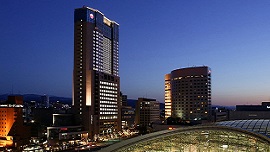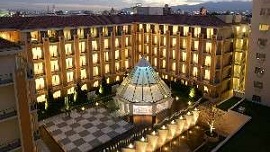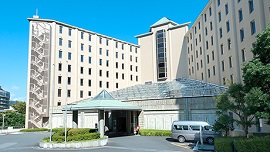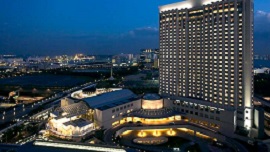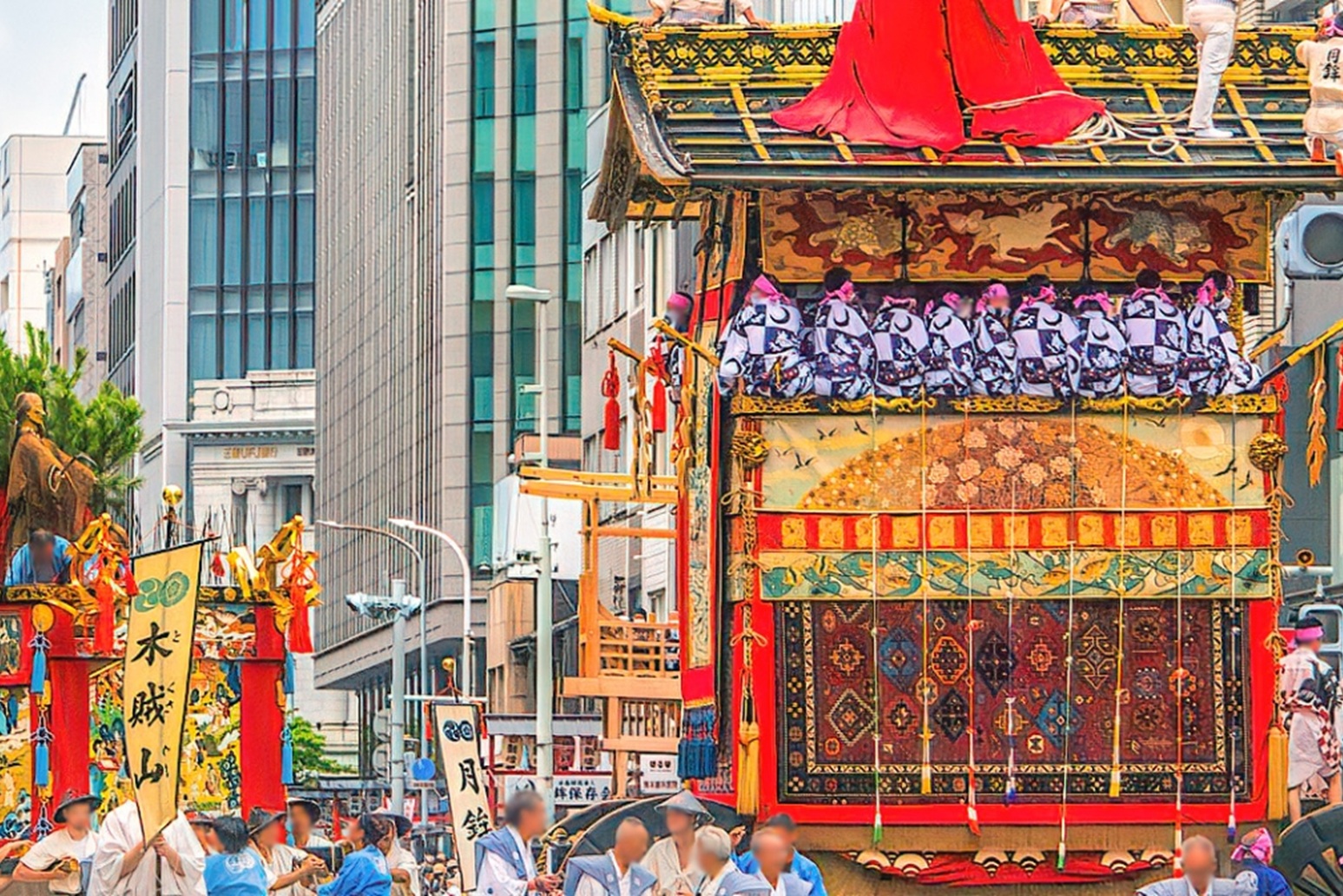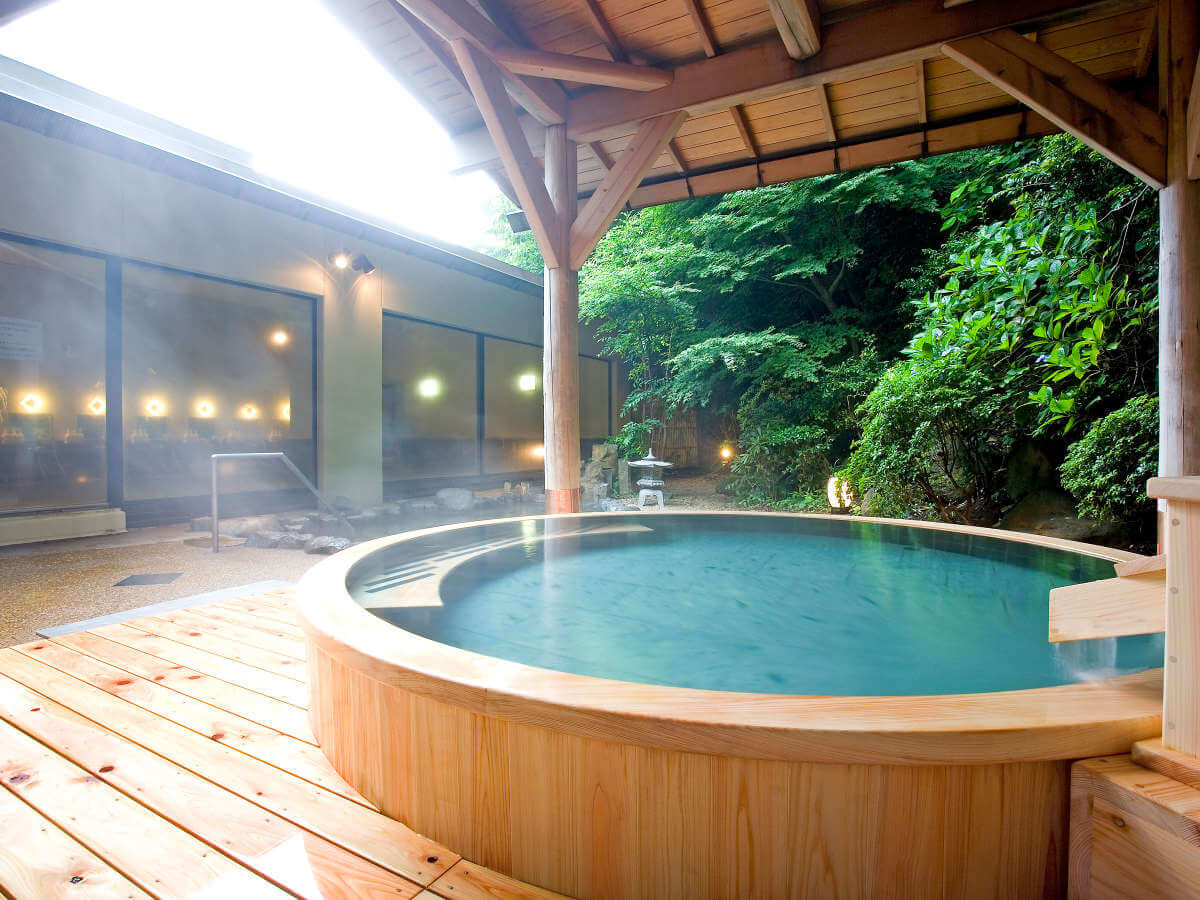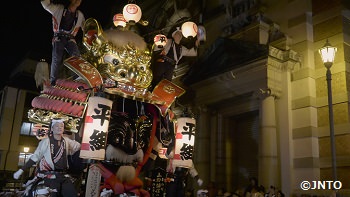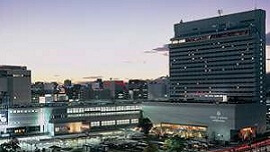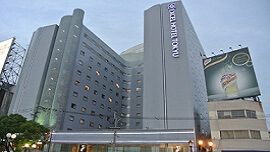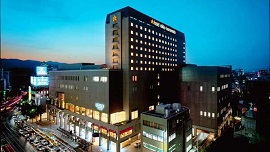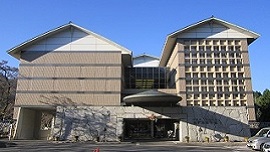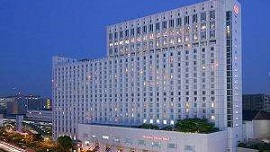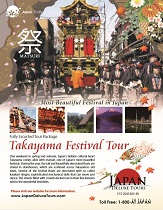-
- USA/Canada 1-800-285-2726
- Australia (02) 8006 4411
Tour Highlights
Matsuri - Spring (April) / Autumn (October)
Takayama Festival
Considered one of the three most beautiful festivals in Japan, the Takayama Festival is held twice a year in spring and autumn in the old town of Takayama. Drawing in large crowds yearly, the Spring Festival (April 14-15) is the annual festival of the Hie Shrine (Sanno-sama) in the southern half of Takayama's old town. Likewise, the Autumn Festival (October 9-10) is the annual festival of the Hachiman Shrine in the northern half of the old town, and the festival is also known as Hachiman Festival. The air is filled with music, the smell of good food, and bright floats and lights. Each festival features its own set of about a dozen festival floats (yatai) that are paraded through the city to celebrate the shrines.

Matsuri - Summer (July)
Kyoto Gion Festival
Possibly the most famous festival in Japan, the Kyoto Gion festival is one of the most vibrant and beautiful matsuris. Filling the month of July with celebrations, the grand procession of floats occurs on the 17th. Known as Yamaboko Junko, the grand procession features two types of floats called Yama and Hoko. There are 23 yama floats and 10 hoko floats, and the festival event on the 17th of July features 23 of the 33, making it the highlight of the Kyoto Gion Festival. The other 10 floats are featured the week after on the 24th of July. These floats fill the city with spectators and fun, drawing in large crowds from around Japan and the rest of the world. Enjoy the tradition and fun while at the Kyoto Gion Festival, a month long celebration in Kyoto, the former capital filled with Japan's traditional culture.

Matsuri - Spring (May)
Asakusa Sanja Festival
Known as Tokyo's wildest festival, the Sanja Matsuri celebrates the history of Asakusa Sensoji Temple. During the festival, the spirits of the Hinokuma Brothers who discovered a statue of the Bodhisattva Kannon, the principal image of Senso-ji Temple, and Nakatomo Hajino who established the temple are celebrated. Mikoshi (portable shrines) bearing the images of the spirits are carried through the Asakusa district with wild energy and vigor, drawing in crowds local and internationally to the festival. Several portable shrines are carried through the city be men, women, and children, with the belief the more intense the shaking and jolting, the more power the spirits will receive. The best highlight of this festival occurs on the final day when the three mikoshi from Asakusa are paraded through the streets. After the mikoshi are returned to Asakusa, there is a ceremonial dance and drum performance to end the festival.
Photo Courtesy of Tokyo Convention & Visitors Bureau

Matsuri - Summer (July/August)
Obon Dance Festival
Obon, celebrated in July or August, is a time when the Japanese commemorate their ancestors and believe the spirits of their ancestors return to them for a brief while. Similar to Mexico's Day of the Dead
or China's Ghost Festival
, Obon is a three day festival filled with many customs to honor the spirits of our deceased ancestors. First, lanterns are hung on the entrances of homes to guide the spirits of their deceased ancestors back home. At the end of the festival, these lanterns are put in rivers and lakes to guide the spirits back to the other world. There is also dancing, called Bon Odori, done to welcome the spirits back into the world. While the dancing varies by region, many participate in the fun and learn as they go. Lastly, Obon marks the time when families visit their ancestors' graves and cemeteries to clean the grave and leave flowers or other offerings. Obon is held all throughout Japan, and even is celebrated in some parts of the United States, Brazil, Canada, Malaysia, and Argentina

Matsuri - Autumn (October)
Karatsu Kunchi Festival
The Karatsu Kunchi Festival is held during Autumn for the Karatsu city's shrine. Labeled an Important Intangible Folk Cultural Property by the Japanese Government, The festival features daily parades of fourteen hikiyama, or massive floats, designed as samurai helmets, dragons, sea creatures, and other magical beasts from Japanese Mythology. These gigantic floats are created with wood, lacquer, and other materials before being finished with gold and silver leaf. While the floats are normally displayed year round at the Karatsu Shrine, the 14 floats come alive when they take the streets while being carried by members selected from families living in the fourteen traditional neighborhoods of Karatsu. The event draws in anywhere from 150,000 to 500,000 people who want to join in the fun and see the history of Japan come to life!

Fireworks Festival
Hanabi
Often in the summer, Japanese Festivals are accompanied with Hanabi, or fireworks. Translating to Fire Flower
, lighting Hanabi is a Japanese summer tradition enjoyed by children and adults alike. Japan has over 100 Hanabi festivals in the summer lighting the skies with colorful bursts of reds, blues, greens, and more. Enjoy the summer festivities with bright fireworks exploding in the sky for an atmosphere unlike any other.

Food & Entertainment
Yatai Food Stalls
Yatai are small open-air food stands that sell mouth-watering, festival foods like Takoyaki, Taiyaki, Chocolate Banana, Crepes, roasted corn with soy sauce, Jaga Butter baked potatoes and more. You can find yatai's at almost all Japanese festivals and during cultural events. The smell of the various foods fill the air, bringing in long lines of hungry patrons, looking for a bite between playing games and dancing the night away. Yatai's are also found at Japanese festivals celebrated outside of Japan, like the Obon Festivals in California or the Japan Festivals in Brazil, proving to be a staple for festival culture!










